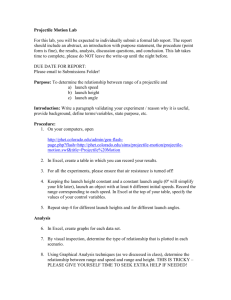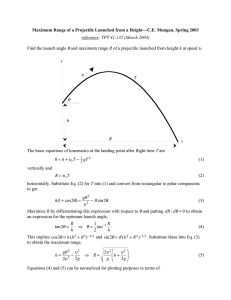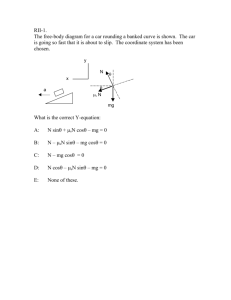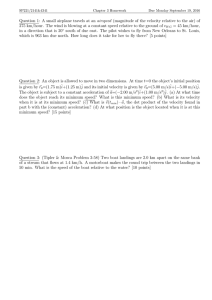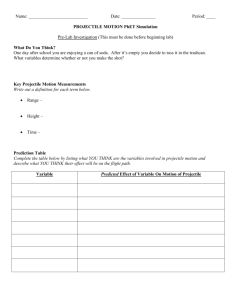Name: __________________________ Date: _______________ Period: ____
advertisement
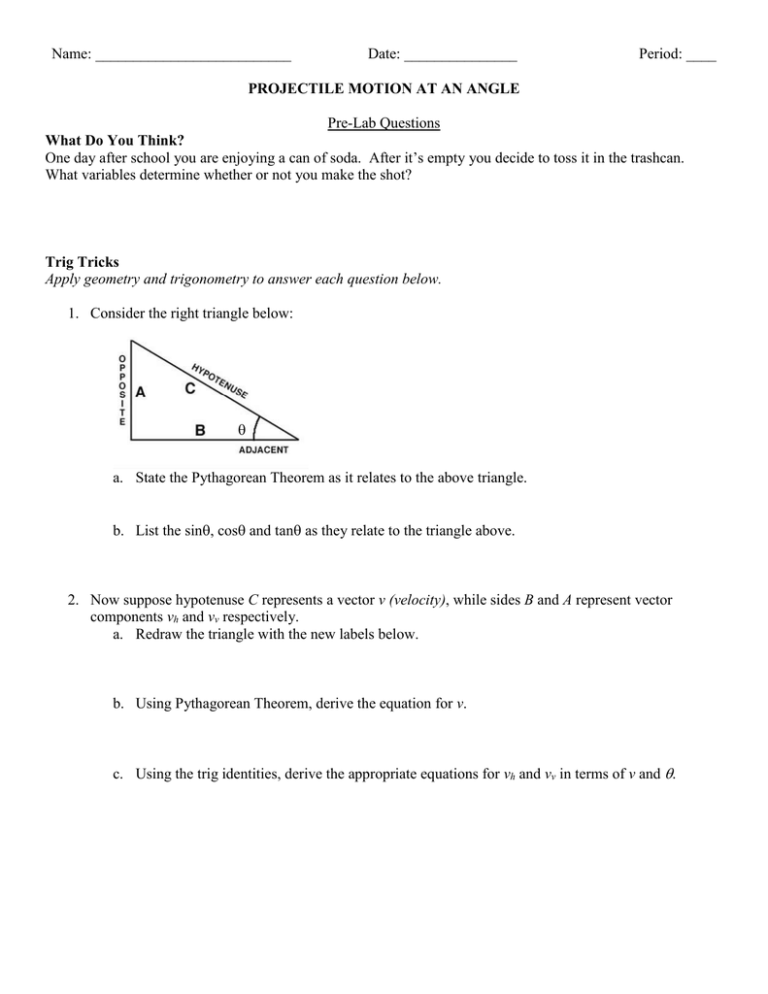
Name: __________________________ Date: _______________ Period: ____ PROJECTILE MOTION AT AN ANGLE Pre-Lab Questions What Do You Think? One day after school you are enjoying a can of soda. After it’s empty you decide to toss it in the trashcan. What variables determine whether or not you make the shot? Trig Tricks Apply geometry and trigonometry to answer each question below. 1. Consider the right triangle below: a. State the Pythagorean Theorem as it relates to the above triangle. b. List the sin, cos and tan as they relate to the triangle above. 2. Now suppose hypotenuse C represents a vector v (velocity), while sides B and A represent vector components vh and vv respectively. a. Redraw the triangle with the new labels below. b. Using Pythagorean Theorem, derive the equation for v. c. Using the trig identities, derive the appropriate equations for vh and vv in terms of v and . vi i max h Prediction Table Complete the table below, showing one of each type of calculation in the correct column (horizontal, vertical). vi (m/s) θ (º) 20 30 20 45 20 60 20 90 vh (m/s) vvi (m/s) t total (s) R (m) hmax (m) Calculations: vh = Horizontal (constant velocity) = ____________ m/s Use the total time for the trip (found in the vertical column), and vh to get your horizontal displacement or range. vvi = Vertical (constant acceleration) ____________ m/s a= –9.8 m/s2 for the total trip, what is the vertical displacement? xv=____________ m (total trip) use vvi, a and xv to get the total time for the trip: ttotal = ____________ s xh= R = ____________ m How much time would it take to get to the top on the path (½ of the trip)? t ½ = _____________ s At the top of the path Vv=0. Find the maximum height the ball reaches. This is the xv at ½ the trip. xv = hmax = _____________ m Lab Activity – Online Simulation 1. Open up the University of Colorado, PhET Projectile Motion simulation http://phet.colorado.edu/simulations/sims.php?sim=Projectile_Motion 2. Spend a few minutes familiarizing yourself with the controls of the simulation before you begin the lab below. 3. PLEASE NOTE: Do not use the numbers for “range” and “height” at the top of the screen as it measures these for the whole of the blue parabola taking into account the 1.2 m height of the cannon (we are doing this problem for when the object returns to its launch height to simplify the problem). Use the tape measure (square with a yellow dot in it) as shown below to measure these values. Also subtract 0.2 s from the time given before recording it in your table. QuickTime™ and a decompressor are needed to see this picture. QuickTime™ and a decompressor are needed to see this picture. measuring range measuring maximum height Test Your Predictions Use the simulation to test your predictions from the previous section. Set the initial conditions and fill in the table using the results you find from the simulation. vo (m/s) θ (º) 20 30 20 45 20 60 20 90 R (m) hmax (m) t (s) Hitting the target with a Buick: The equations for the horizontal and vertical parts of a projectile motion problem can be combined into the following equations for the range and maximum height of a projectile that begins and ends at the same elevation (i.e. the vertical displacement for the whole trip = zero.) vi is the total launch velocity, the launch angle and g is the acceleration due to gravity. R =(vi2/g) sin2 hmax = (vi sin)2/(2g) 1. Move the target so that it lies along the horizontal or x-axis as shown below. Use the tape measure to measure the distance to the target. R = ____________ m QuickTime™ and a decompressor are needed to see this picture. 2. Using the equation above for range, find the launch velocity necessary to hit the target if fired at the following angles. Show your calculations next to the table. Try your predictions with the simulation (fire a Buick!). If you don’t hit the target, redo your calculations until you are correct. Calculations: distance launch launch speed to target angle to hit target (m) (o) (m/s) 30o 45o 60o 3. What do you notice about the launch speeds for 30o and 60o? Looking at the range equation, why do you think this is true? For which angle does the Buick go higher? Why do you think this is true? 4. Calculate the range for a Buick launched at 40 m/s, 20o? What other angle gives the same range for the same launch speed? Prove your answer with a calculation 5. Launch a golf ball at 40 m/s, 20o. Measure the range on the simulation with the measuring tape.. how does it compare to the range of the Buick? Post-Lab Questions Compare your predicted values with your actual values and answer the following questions. 1. Were any of your predictions different from your tested results? If so, which one(s), and why? 2. Name at least two things that surprised you about projectile motion after performing this lab. 3. You should have found that launch angle is a key variable. a. What angle causes the largest height? b. What angle causes the largest range?

